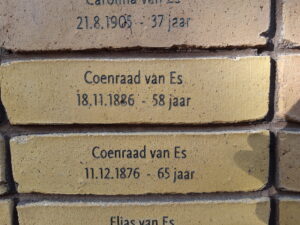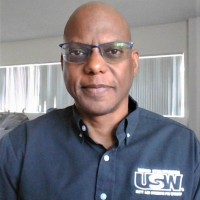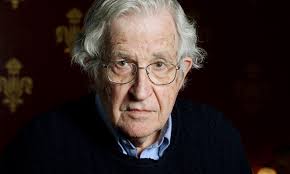Holocaust Namenmonument Nederland
 Holocaust Namenmonument Nederland
Holocaust Namenmonument Nederland
Ruim 102.000 slachtoffers van de Holocaust hebben na meer dan 75 jaar na de Tweede Wereldoorlog een eigen monument gekregen. In Amsterdam is een monument verrezen met alle namen van de Nederlandse Holocaustslachtoffers die geen graf hebben. Alle namen van Joden, Sinti en Roma die vanuit Nederland zijn vervolgd en gedeporteerd, alsmede gedeporteerde Nederlandse Joden woonachtig in andere landen, die in naziconcentratie- en vernietigingskampen zijn vermoord, alsook zij die zijn omgekomen door honger of uitputting tijdens transporten en dodenmarsen en waar geen graf van bekend is (lees ook: Welke namen komen er op het monument?). Daarmee heeft Nederland eindelijk een tastbaar gedenkteken waar 102.000 Joden en 220 Sinti en Roma zowel individueel als collectief kunnen worden herdacht.
Tot aan september 2021 kende Nederland geen monument waar elk individueel slachtoffer van de Holocaust met naam en toenaam wordt genoemd.
Massavernietiging
Tussen 1933 en 1945 zijn naar schatting 6 miljoen Joden en honderdduizenden Sinti en Roma omgebracht door de nazi’s. Van de 140.000 Joden die in 1940 in Nederland woonden, hebben er 102.000 de oorlog niet overleefd.
Niet alle Joden zijn vermoord in de gaskamers van vernietigingskampen zoals Auschwitz-Birkenau, Treblinka, Belzec, Majdanek, Chelmno en Sobibor. Velen zijn omgekomen door massa-executies, ziekte, honger, uitputting of het verrichten van slavenarbeid. Het Holocaust Namenmonument Nederland herdenkt al deze slachtoffers.
 Ontwerp Holocaust Namenmonument
Ontwerp Holocaust Namenmonument
Het Nederlandse Auschwitz Comité heeft samen met de Pools-Joodse architect Daniel Libeskind op 16 december 2016 het nieuwe ontwerp voor het Holocaust Namenmonument Nederland gepresenteerd. Dit nationale monument is – meer dan 70 jaar na afloop van de Tweede Wereldoorlog – gerealiseerd in het hart van het Joods Kwartier in Amsterdam, daar waar het zich heeft afgespeeld.
Het monument omvat vier Hebreeuwse letters die samen het woord weergeven, dat ‘In herinnering aan’ betekent. Als bezoekers de gedenkplaats binnenkomen treden zij een labyrint van gangen tegemoet met aan beide zijden twee meter hoge bakstenen muren die de boodschap ‘In herinnering aan’ dragen. Op elk van de 102.000 stenen wordt een naam, geboortedatum en de leeftijd bij overlijden gegraveerd, zodanig dat de namen van de slachtoffers aanraakbaar zijn. De muren met namen dragen vier objecten van spiegelend roestvrijstaal.
Daniel Libeskind ontwerper Holocaust Namenmonument Nederland
Het Holocaust Namenmonument Nederland wordt ontworpen door de Pools-Amerikaanse architect Daniel Libeskind (Lodz, 1946). In New York zei Libeskind ‘vereerd’ te zijn met de uitnodiging voor Nederland een Holocaustmonument te ontwerpen.
 Libeskind is de zoon van Holocaust-overlevenden. In 1964 emigreerde hij met zijn familie naar Amerika. Als architect verwierf Libeskind vooral bekendheid met zijn ontwerpen voor het Joods Museum in Berlijn en het masterplan voor de herbouw van het World Trade Center in New York. In mei 2013 werd Libeskind ook al aangewezen als architect van een Holocaust memorial in Columbus, de hoofdstad van de Amerikaanse staat Ohio.
Libeskind is de zoon van Holocaust-overlevenden. In 1964 emigreerde hij met zijn familie naar Amerika. Als architect verwierf Libeskind vooral bekendheid met zijn ontwerpen voor het Joods Museum in Berlijn en het masterplan voor de herbouw van het World Trade Center in New York. In mei 2013 werd Libeskind ook al aangewezen als architect van een Holocaust memorial in Columbus, de hoofdstad van de Amerikaanse staat Ohio.
Libeskinds studio ontwierp vele musea en andere culturele en openbare gebouwen verspreid over de wereld. Libeskind zelf bekleedde een groot aantal leerstoelen, onder meer aan de Universiteit van Toronto, waar hij als eerste de Frank O. Gehry leerstoel bezette. De lange lijst van prijzen die hij ontving, vermeldt ook de Hiroshima Kunst Prijs (2001) voor kunstenaars die in hun werk internationaal begrip en vrede propageren. De prijs was niet eerder aan een architect toegekend.
In 2011 hield Libeskind de achtste Nooit Meer Auschwitz Lezing in Amsterdam, bij welke gelegenheid hem de Annetje Fels Kupferschmidt Onderscheiding werd uitgereikt. De prijs wordt jaarlijks uitgereikt aan een persoon of organisatie die zich op buitengewone wijze verdienstelijk heeft gemaakt voor het realiseren van de doelstellingen van het Nederlands Auschwitz Comité.
Zie: https://www.holocaustnamenmonument.nl
Ending The Fossil Fuel Era Is The Only Way To Halt Global Warming And Stop Environmental Injustice

C.J. Polychroniou
01-24-2024 ~ The decarbonization ideals underlying the Green New Deal provide the only realistic way to halt global warming and build a sustainable, resilient, and equitable future.
Environmental justice is a crucial component of the broader struggle for a sustainable, resilient, and equitable future. So is the end of the fossil fuel era; in fact, decarbonization and environmental justice go hand in hand.
The environmental justice movement traces its origins to the Civil Rights Movement of the 1960s. As such, it is deeply rooted in black history.
The Memphis Sanitation Strike in 1968, which drew Martin Luther King Jr., is regarded as the first nationally mobilized protest against environmental injustice.
In 1982, African Americans organized a mass protest against a polychlorinated biphenyl (PCB) landfill in Warren County, North Carolina, an event that served as the catalyst for the birth of a political movement dedicated to fighting environmental injustice and environment racism. Read more
Unions Have The Potential And The Responsibility To Advance A “Just Transition”
The idea of a “just transition” has emerged as an absolute requirement for any progress toward a clean energy future. An energy transformation will impact workers in the fossil fuel industry but will also affect regions and communities differently. A just transition must be designed to ensure that the benefits of greening the economy are shared widely and that no worker is left behind.
Norman Rogers, a 20-plus-years employee of a southern California refinery and second vice president of United Steelworkers (USW) Local 675, also serves on the Joint Health and Safety Committee and Negotiating Committee at the refinery. In this interview, Rogers shares his insights on the principles and aims of a just transition and how we could get there.
C.J. Polychroniou: “Just transition” is associated with the environmental transition, in sectors such as chemicals and energy, although it is now moving into other areas such as health care and even development. Can you talk, from your experience as a refinery worker and labor organizer, about what the notion of just transition entails and how it is being used in connection with workers in the fossil fuel industry?
Norman Rogers: The term “just transition” is very much linked with the labor movement. Tony Mazzocchi, a trade unionist with the Oil Chemical and Atomic Workers union (OCAW), coined the term as it related to the dangerous, toxic, life-threatening chemicals to which his members were exposed. The idea then, as it is now, is to find other ways to meet the needs for the products being made and the health and welfare of the workforce he represented.
Today, the move to renewables, the increase in the use of electric vehicles and even steel being made without the petroleum coke (petcoke) from the refining process is set to have a profound impact on the number of fossil fuel industry jobs. Knowing what the future holds and the serious repercussions set to take place, and planning for that outcome, that is what the call for a just transition is all about.
As a labor organizer representing fossil fuel workers in the current atmosphere, the philosophy behind a just transition is ensuring that no worker is left behind when transitioning to a clean energy economy. Everyone must be accounted for, whether they are toward the end of their career, just starting out, or any point in between. This fight must be won if the transition to a sustainable future is to be realized. To the extent that we do not do this, we will not be successful in building the community of allies needed for the task at hand.
It’s been said that a just transition is absolutely essential for effective climate action. Why is this so, and what role can trade unions play in facing the challenges of global warming?
A just transition is essential because, at the end of the day, the decisions to be made to address climate concerns are ultimately going to take place in the ballot booth, and to the extent people see their jobs going away, without alternatives, their vote [will] be to maintain the status quo. There has to be a pathway for those folks set to lose their jobs to move into other careers. And this reaches beyond people working in oilfields and refineries to people building mufflers, engine blocks and transmission housings.
As we transition toward the new economy and the attention we give to it being “just,” we must ensure there is justice as well. The new jobs that come online and the allocation of resources must be made available to all; the sustainable future being touted must include all stakeholders: fossil fuel workers, fence-line communities, Indigenous people, the underemployed — they all must be accounted for as we move forward. The benefits of a decarbonized future must be shared by all and the framework we build to make that happen is an integral part of any success we hope to achieve. A just path to a decarbonized future is absolutely critical to an ecologically sustainable economy. The costs of achieving a green economy should not be borne by those who have suffered and been excluded by the injustices associated with industrialization. I quote my father when I say, “Failing to plan is planning to fail.”
A successful transition can only be achieved through social dialogue, consultation with those most directly affected by a decarbonized future and recognition there may be more than one path forward. Unions have a key role to play given the move to a green economy so fundamentally impacts the lives of workers. Unions have the potential, the responsibility, to advance the cause of a transition that is just. They must help ensure that workers, and the communities in which they live, receive a fair deal. Organized labor has a long, rich history of fighting for an equitable future for workers; the same must hold true now as we move to a decarbonized future.
Labor unions are divided over the Green New Deal. Some trade unions support a transition away from fossil fuels, while others seem to express apprehension, anxiety and fear over the prospect of a transition to clean, renewable energy sources. However, the prevailing view seems to be that “jobs vs. the environment” is a false dichotomy, a false choice. How do you and the union you represent look at the issue of “jobs vs. the environment”?
Without a doubt, there is a great deal of division in regards to climate concerns but, to a certain extent, one’s view of climate concerns are almost a moot point given the changes taking place. If one keeps track of the number of television ads for electric cars over the course of a weekend, it becomes obvious the landscape is changing, and these are changes that mean a drop in demand for fossil-fuel-powered vehicles. Add to that, in California, new fossil-fuel-powered passenger cars will no longer be sold after 2035. It should be noted there are numerous other states making similar moves. With that, the debate over jobs vs. the environment becomes unproductive given that the focus should be how we make the jobs to come good-paying union jobs.
New work is coming and with it, a new workforce is needed. The number of jobs associated with the clean energy economy already surpass those in the fossil fuel industry, and with the predictions these jobs are set to further increase in number, we can help bury the “jobs vs. environment” debate by ensuring these new jobs are quality jobs that support families and communities in ways that the current fossil fuel jobs have for close to a century.
From a practical standpoint, what would a just transition model actually look like?
Speaking only for myself, a just transition model must include income support for workers during the transition. Also, solid, well-financed training and re-training programs with a clear path to access the new jobs generated is necessary. With the jobs to come, strong collective bargaining must be a part of the picture. Similarly, as we start from scratch, sustainable development tools for economically disadvantaged communities must be incorporated so everyone benefits from what’s to come. The list of course should be expanded to include specific government policies aiming to integrate strong social protection measures for those at risk of losing their jobs and those unemployed workers in communities harmed by the challenges and threats of global warming.
What are the best strategies for creating enduring labor-environmental alliances?
The chief strategy I can suggest is that we need allies everywhere we can find them, and there is a language and a type of discussion that exists when we are speaking to allies. There has been a great deal of demonization that has taken place in reference to the fossil fuel industry and those who work there. An understanding is needed that those folks working these jobs are people doing the right thing; they have put roofs over their family’s heads, food on the table and supported the communities in which they live. And everyone, everyone has benefited from the fruits of their labors, whether it be hopping a flight for an overseas vacation or a road trip or the syringes that deliver the vaccinations to help fend off the coronavirus.
We are now being told that the right thing to do is for us to lose our jobs, jobs which in many cases have been multigenerational and, after decades of collective bargaining, have become good-paying jobs. If we can move to a place where there is recognition of these concerns, it creates a space where the discussions that need to take place about a path forward can happen. The goals of meeting climate challenges and the realities of people being able to support their families and communities need not be the “us or them,” either/or proposition it is being made out to be. It is a chance for us to see how well we can listen and then how clever we can be with what we’ve heard.
Source: https://truthout.org/unions-have-the-potential-and-the-responsibility-to-advance-a-just-transition/
C.J. Polychroniou is a political scientist/political economist, author, and journalist who has taught and worked in numerous universities and research centers in Europe and the United States. Currently, his main research interests are in U.S. politics and the political economy of the United States, European economic integration, globalization, climate change and environmental economics, and the deconstruction of neoliberalism’s politico-economic project. He is a regular contributor to Truthout as well as a member of Truthout’s Public Intellectual Project. He has published scores of books and over 1,000 articles which have appeared in a variety of journals, magazines, newspapers and popular news websites. Many of his publications have been translated into a multitude of different languages, including Arabic, Chinese, Croatian, Dutch, French, German, Greek, Italian, Japanese, Portuguese, Russian, Spanish and Turkish. His latest books are Optimism Over Despair: Noam Chomsky On Capitalism, Empire, and Social Change (2017); Climate Crisis and the Global Green New Deal: The Political Economy of Saving the Planet (with Noam Chomsky and Robert Pollin as primary authors, 2020); The Precipice: Neoliberalism, the Pandemic, and the Urgent Need for Radical Change (an anthology of interviews with Noam Chomsky, 2021); and Economics and the Left: Interviews with Progressive Economists (2021).
Lumen Travo Gallery – Amsterdam: Joseph Sassoon Semah – Solo exhibition ‘On Friendship / (Collateral Damage) IV
Joseph Sassoon Semah – Solo exhibition ‘On Friendship / (Collateral Damage) IV
Lumen Travo Gallery – Jan. 22 – March 12, 2022. Lijnbaansgracht 314, 1017 WZ Amsterdam
On the occasion of his solo show at Lumen Travo Gallery, Joseph Sassoon Semah takes us on a journey of a critical analysis of Joseph Beuys and the Germany’s post-war history.
(see http://www.lumentravo.nl/exhibitions#on-friendship-collateral-damage-iv-how-to-explain-hare-hunting-to-a-dead-german-artist-the-usefulness-of-continuous-measurement-of-the-distance-between-nostalgia-and-melancholia
 On Friendship / (Collateral Damage) IV
On Friendship / (Collateral Damage) IV
How to Explain Hare Hunting to a Dead German Artist
[The usefulness of continuous measurement of the distance between Nostalgia and Melancholia]
 Exhibition curated by Linda Bouws
Exhibition curated by Linda Bouws
Noam Chomsky: GOP’s Soft Coup Is Still Underway One Year After Capitol Assault
In the third and final presidential debate of 2016, Donald Trump had signaled that he might not concede the election should he lose to Hillary Clinton. However, he did say to his supporters a day later that he would definitely accept the results of the election if he won.
Trump’s threat to reject democratically run election results should have disqualified him from running for the highest office in the land.
But instead he went on to win the 2016 election and then divide the country like no other incoming president. And when he lost the 2020 election to Joe Biden, he not only refused to concede defeat, but he also sought to block the certification of the electoral vote by urging his fanatical supporters gathered at the U.S. Capitol on January 6, 2021, to “stop the steal” of the election. Months earlier, he had already put his base on high alert by saying, “The only way we’re going to lose this election is if the election is rigged.”
Under a less incompetent wannabe strongman, the assault on the Capitol could have led to the actual overthrow of the U.S. system of representative democracy. But the January 6 attack instead featured Trump’s hallmark disorganization and lack of a coherent plan.
A day after the attempted coup, Trump announced that there would be an “orderly transition” of power on January 20, but that did not mean that he had plans to “go gentle into that good night.” On the contrary, he continued to spread lies about the 2020 election, which he himself called the “Big Lie,” even after he had failed to convince officials in Georgia and Arizona to overturn those states’ results. Trump’s personal lawyer, Rudy Giuliani, also tried to convince a federal judge in Williamsport, Pennsylvania, to overturn hundreds of thousands of votes in the state.
Trump’s position was quite simple: If democracy fails to give me the desired election results, damn democracy!
Trump’s “Big Lie” continues to hold sway over the overwhelming majority of Republicans voters, and the Republican Party itself is increasingly unwilling to accept defeat. Subsequently, states with Republican legislatures have passed waves of new laws restricting voting and are taking over local and state election boards. These developments speak volumes of the anti-democratic mindset that has become the trademark of the GOP in the Trump era.
In the interview that follows, Noam Chomsky reflects on the anniversary of the January 6 insurrection and offers us his own insights on what may lie ahead in a country where a very sizable segment of the population still believes in Trump’s lies.
Noam Chomsky is internationally recognized as one of the most important intellectuals alive. His intellectual stature has been compared to that of Galileo, Newton and Descartes, and his work has had tremendous influence on a variety of areas of scholarly and scientific inquiry, including linguistics, logic and mathematics, computer science, psychology, media studies, philosophy, politics and international affairs. He is the author of some 150 books and recipient of scores of highly prestigious awards, including the Sydney Peace Prize and the Kyoto Prize (Japan’s equivalent of the Nobel Prize), and of dozens of honorary doctorate degrees from the world’s most renowned universities. Chomsky is Institute Professor Emeritus at MIT and currently Laureate Professor at the University of Arizona.
C.J. Polychroniou: A year ago, on January 6, 2021, a mob of Donald Trump’s supporters broke into the U.S. Capitol in an attempt to block certification of the electoral votes — a routine procedure following a presidential election — that would have formalized Joe Biden’s victory. The Capitol building had been breached on a few occasions in the past, but this was the first time in the history of the country that an assault on democracy was actually incited by an outgoing president. In fact, months later, former President Trump would go so far as to condemn the criminal prosecution of those who took part in the Capitol attack that day even though he had denounced the insurrection after he had been impeached over it. From your perspective, Noam, how should we understand what happened on January 6, 2021?
Noam Chomsky: Participants in the assault on the Capitol doubtless had varying perceptions and motives, but were united in the effort to overthrow an elected government; in short, an attempted coup, by definition. It was furthermore an attempt that could have succeeded if a few prominent Republican figures had changed their stance and gone along with the coup attempt, and if the military command had made different decisions. Trump was making every effort to facilitate the coup, which would surely have been applauded by a large majority of Republican voters and by the Republican political leadership, which, with a few exceptions, grovels at his feet in a shameful display of cowardice.
Implications for the future are all too clear. The Republican organization — it’s hard to regard them any longer as an authentic political party — is now carefully laying the groundwork for success next time, whatever the electoral outcome may be. It’s all completely in the open, not only notconcealed but in fact heralded with pride by its leaders. And regularly reported, so that no one who is interested enough to pay attention to the American political scene can miss it. To mention just the most recent discussion I’ve seen, the Associated Press describes how the GOP is carrying out a “slow-motion insurrection” and has become “an anti-democratic force,” something that has not happened before in American politics. A few weeks earlier, Barton Gellman outlined the plans in detail in The Atlantic.
There is no need to review the many well-known flaws of the formal democratic system: the radically undemocratic Senate, the enormous role of concentrated wealth and private power in determining electoral outcomes and legislation, the structural advantages provided to a traditionalist rural minority, and much else. But there are also broader issues.
What was progressive in the 18th century is by now so antiquated that if the U.S. were to apply for membership in the European Union, it would probably be rejected as not satisfying democratic norms. That raises questions that merit more attention than they receive.
With all due respect for the Founders, one question — raised by Thomas Jefferson in his own terms — is why we should revere the sentiments of a group of wealthy white male 18th-century slaveowners, particularly now that the amendment system has succumbed to the deep flaws of the formal political system. No less curious are the legal doctrines of originalism/textualism that call on us to decipher their pronouncements with little regard to social and economic conditions as a decisive guide to judicial action. Looking at our political culture from a distance, there is a lot that would seem passing strange. Read more
California’s Cap-And-Trade System Proves Limits Of Market-Based Climate Action
California is not making sufficient progress to meet the 2030 emissions goals. With current policies, it could take easily at least a couple more decades before the 2030 goals are met.
California has cast itself as a leader in the fight against climate change and global warming. The state set the stage for its transition to a low-carbon economy with the passage of AB32, the California Global Warming Solutions Act of 2006, which called for a reduction of greenhouse gas emissions to 1990 levels by 2020, and ultimately reducing them 80 percent below 1990 levels by 2050. AB32, signed by Governor Arnold Schwarzenegger (R), was carried out by various state agencies, and its implementation was funded by a fee collected from large sources of greenhouse gas emissions.
AB32 was the first program in the country to embark on a comprehensive approach to address the looming threats of global warming while keeping economic growth on a solid track. And it was, initially, a moderate success. Emissions fell for the first time below 1990 levels. In fact, the reduction of greenhouse gas emissions returned to 1990 levels four years ahead of schedule, while California’s economy kept growing.
In 2016, Governor Jerry Brown (D) extended AB32 with the passage of SB32, which raised the goal for greenhouse gas emissions to 40 percent below 1990 levels by 2030.
California’s greenhouse gas emissions reduction policies revolve around the promotion of zero-emissions electric vehicles, imposing limits on the carbon content of gasoline, and implementing a cap-and-trade mechanism for polluters.
Briefly, a cap-and-trade system is one where the government sets a cap on the maximum level of emissions and creates allowances in tune with that cap. Polluters obtain and surrender a permit for each unit of emissions. They can obtain permits from the government or through trading with other emitting firms. California’s cap-and-trade program is the main component in the state’s plan to reduce emissions and bolster a clean energy economy
The current Governor of California, Gavin Newsom (D), has also taken some bold measures to combat climate change and global warming by moving the economy further away from fossil fuels. These include ending the sale of new gas cars by 2035, phasing out harmful oil production by no later than 2045 statewide, and pushing forward a $15 billion climate package to tackle wildfire and drought challenges.
All in all, California has aligned itself with the emissions reduction targets set by the Intergovernmental Panel on Climate Change for limiting global warming to 1.5 degrees Celsius. It has committed itself to reducing emissions to 40 percent below 1990 levels by 2030 and going carbon neural by 2045.
California’s efforts in leading the fight against the climate crisis is the result of bipartisan political support and overall public support. According to a 2019 study by the Public Policy Institute of California, majorities of Californians regard global warming a very serious threat and are in support of the state’s renewable energy goals. A plurality of adults (48%) and likely voters (45%) also said that policies to combat global warming will lead to more jobs.
This is not to say of course that there hasn’t been opposition to California’s global warming policies. California Business Roundtable is one organization that has consistently raised objections to aggressive climate policies because of its concerns that such efforts were hurting companies. Many progressives, on the other hand, have been quite critical of the state’s cap-and-trade system. They oppose it as being too business friendly, a stance probably vindicated by the mere fact alone that California Business Roundtable has offered enthusiastic support to this “market-based mechanism” for controlling emissions.





